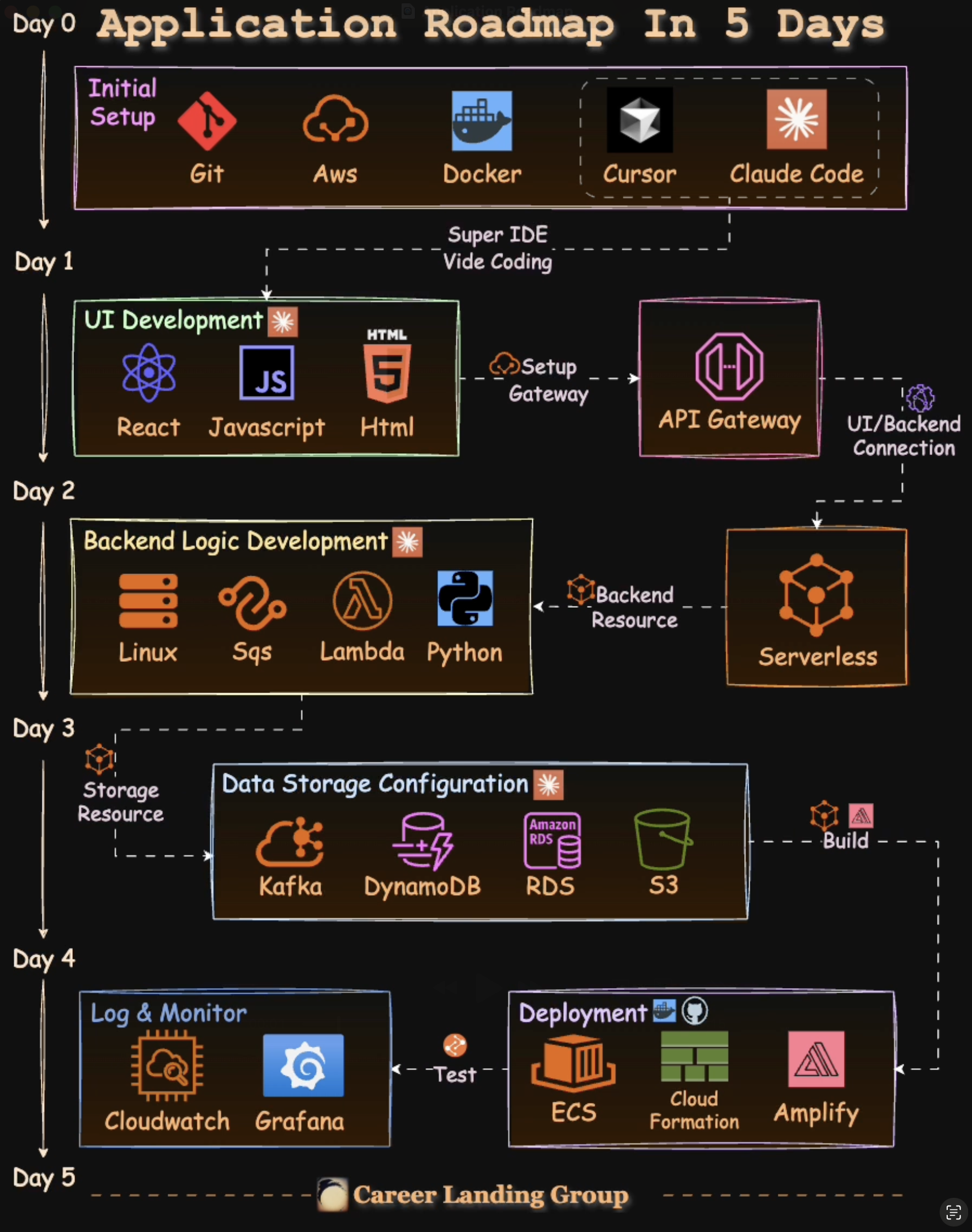
This 5-day roadmap walks you through building and shipping a production-ready web application using modern technologies, AI-enhanced development tools, and AWS cloud services—all while upskilling your full-stack engineering abilities.
Day 1 – Environment Setup(Estimated: 7 hours):
Set up the foundational tools and environments for your application:
Git (15 min):
Version control system for tracking and managing your codebase.
AWS (15 min):
Establish your cloud environment to deploy and manage backend services.
Docker (30 min):
Containerize your application for consistent development, testing, and deployment across environments;
Cursor IDE + Claude AI Coding Assistant (1 hour):
Install and integrate Cursor with Claude Sonnet 4. This combination serves as an advanced AI-powered IDE to accelerate your coding workflow. Use ChatGPT or Claude to walk through early use cases and address setup questions interactively.
AWS Amplify (2 hours):
Initialize an Amplify application with GitHub integration. Amplify streamlines frontend CI/CD, hosting, SSL setup, and routing—saving hours of manual configuration.
AWS SAM(Serverless Application Model) (3 hours):
Install and configure SAM CLI to manage backend infrastructure via IaC (CloudFormation). Set up your Lambda functions using Python in a Linux runtime and follow SAM tutorials for initial deployment workflows.
Day 2 – UI Development (Estimated: 8 hours):
Framework Initialization (30 min):
Create your UI project using React (JavaScript/HTML/CSS). Use Cursor’s setup presets for rapid scaffolding. If preferred, you can use alternative modern frameworks like Next.js or Vue.js.
Frontend Vibe Coding (7 hours):
Focus exclusively on UI feature development. Use Claude Code and Cursor to generate components based on your design. Avoid backend dependencies at this stage.
API Gateway Setup (30 min):
Configure AWS API Gateway to route frontend requests to backend Lambda endpoints, preparing the system for integration.
Day 3 – Backend Development (Estimated: 8 hours):
SAM Backend Configuration (1 hour):
Define Lambda function handlers using Python, connected to the API Gateway. Validate the end-to-end path from frontend request to backend response.
Lambda Function Setup (1 hour):
Develop and deploy a functional Lambda to process incoming requests and perform core logic.
Backend Development with AI (6 hours):
Use prompt-based development via Cursor + Claude to implement backend logic. Add “TODO” comments for future enhancements like caching or persistence.
Backend Framework(Optional):
Use a backend framework like FastAPI for complex routing or async handling.
Queuing System(Optional):
Allocate AWS SQS resource for queuing techniques between API Gateway and Lambda function to improve event handling reliability.
Day 4 – Data Storage Configuration (Estimated: 8 hours):
Database Setup (1 hour):
Provision a database via AWS SAM—use DynamoDB for fast and flexible NoSQL or mixed data. Ideal for MVPs due to low cost, speed, and schema flexibility.
Schema Design & Integration (5 hours):
Design data models and schemas. Prompt AI to help generate access patterns, then implement and test read/write operations in your backend.
Development Test (2 hour):
Test frontend and backend independently. Use logging tools and basic test scripts to verify end-to-end functionality.
RDS Relational Database(Optional):
Use if relational modeling is needed later.
S3 File Storage(Optional):
Useful for storing files like resumes, images, PDFs.
High Availability System(Optional):
Caching and high availability systems like Kafka or Redis are not essential for the MVP stage. But drill in to setup and integrate if interested.
Day 5 – Deployment, Monitoring, and Final Test (Estimated: 7 hours):
Frontend Deployment (1 hour):
Deploy UI through AWS Amplify. Connect to GitHub, configure environment variables, and publish to a public URL. Amplify includes build previews, smoke tests, and free-tier hosting.
Backend Deployment (3 hour):
Use SAM to containerize your application (optionally using ECS for service orchestration). Define all backend resources in template.yaml and deploy via CloudFormation.
Cloudwatch Prod Test (3 hours):
Monitor live logs and events using AWS CloudWatch. Conduct system-level testing to ensure requests flow from frontend to backend and database as expected.
System Monitoring(Optional):
Use monitor systems like Grafana or AWS X-Ray for detailed application performance monitoring and distributed tracing.
Resources:
Git: https://git-scm.com/
AWS: https://aws.amazon.com/
Docker: https://www.docker.com/
Cursor: https://cursor.com/en
Cursor Rules: https://github.com/PatrickJS/awesome-cursorrules
Claude Code: https://www.anthropic.com/claude-code
Claude Sonnet 4: https://www.anthropic.com/claude/sonnet
React: https://react.dev/
NextJS: https://nextjs.org/
Vue.js: https://vuejs.org/
API GateWay: https://aws.amazon.com/api-gateway/
AWS Serverless Application Model: https://aws.amazon.com/serverless/sam/
AWS SQS: https://aws.amazon.com/sqs/
AWS Lambda: https://aws.amazon.com/lambda/
FastAPI: https://fastapi.tiangolo.com/
Kafka: https://aws.amazon.com/what-is/apache-kafka/
DynamoDB: https://aws.amazon.com/dynamodb/
RDS: https://aws.amazon.com/rds/
S3: https://aws.amazon.com/s3/
ECS: https://aws.amazon.com/ecs/
CloudFormation: https://aws.amazon.com/cloudformation/
Amplify: https://aws.amazon.com/amplify/
Cloudwatch: https://aws.amazon.com/cloudwatch/
AWS X-Ray: https://aws.amazon.com/xray/
Grafana: https://grafana.com/
